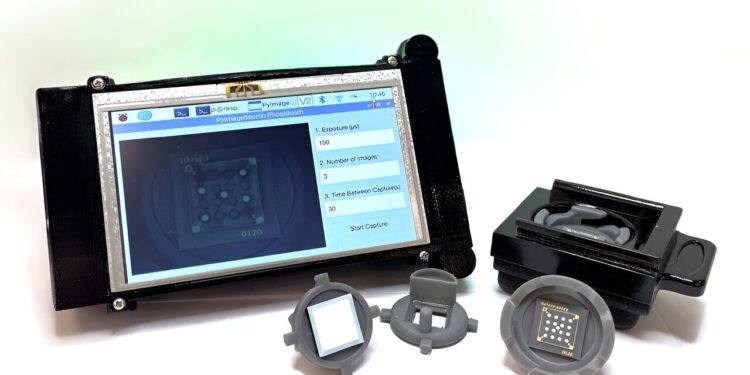Deep learning-enhanced paper-based vertical flow assay for high-sensitivity troponin detection using nanoparticle amplification. Credit: Ozcan Laboratory @UCLA
In a significant advancement for point-of-care medical diagnostics, a team of UCLA researchers introduced a deep learning-enhanced paper-based vertical flow test (VFA) capable of detecting cardiac troponin I (cTnI) with high sensitivity. This innovative test has the potential to democratize access to rapid and reliable cardiac diagnostics, particularly in resource-limited settings.
Cardiovascular disease (CVD) remains the leading cause of death worldwide, accounting for more than 19 million deaths per year. Early detection of acute myocardial infarction (AMI), commonly known as a heart attack, is essential to improve patient outcomes and reduce mortality rates. However, the high costs and infrastructure requirements associated with traditional laboratory diagnostic equipment often limit access to high-quality care, particularly in low- and middle-income settings.
To address this challenge, UCLA researchers developed a high-sensitivity vertical flow test (hs-VFA) that combines the accuracy of traditional laboratory tests with the convenience and affordability of point-of-care technologies. Their findings, detailed in an article recently published in ACS Nanodemonstrate that this innovative platform can accurately quantify cTnI levels in just 15 minutes using a small serum sample, making it ideal for rapid diagnosis in emergency situations or remote locations.
The core of this platform lies in the integration of deep learning algorithms with cutting-edge nanoparticle amplification chemistry. The hs-VFA system uses time-lapse imaging and computational analysis to improve detection of cTnI, a key biomarker of cardiac injury, achieving a detection limit as low as 0.2 picograms per milliliter (pg/mL). This level of sensitivity far surpasses current point-of-care devices and meets the clinical requirements for high-sensitivity troponin testing, essential for the early diagnosis of AMI.
“We are excited to introduce this portable, low-cost solution that bridges the gap between central laboratory diagnostics and point-of-care testing,” said Professor Aydogan Ozcan, lead author of the study and holder of the Volgenau Chair for Engineering Innovation at UCLA. . “Our paper-based platform, powered by deep learning, provides an efficient alternative to the bulky and expensive instruments currently used in hospitals. It promises to bring advanced cardiac diagnostics to underserved populations around the world.
The hs-VFA system operates in two stages: an initial immunoassay phase followed by a signal amplification phase. In the immunoassay phase, the test uses gold nanoparticle conjugates to bind to cTnI in serum. In the signal amplification phase, gold ions are catalyzed by nanoparticles, resulting in a color change that is captured by a custom-designed portable reader. Deep learning algorithms then analyze these time-lapse images to improve the sensitivity and accuracy of cTnI detection.
In rigorous testing using both spiked and clinical serum samples, hs-VFA demonstrated high accuracy with a coefficient of variation (CV) less than 7%. It also showed a strong correlation with reference laboratory analyzers. Importantly, hs-VFA also demonstrated a wide dynamic range, covering cTnI concentrations from 0.2 pg/mL to 100 nanograms per milliliter (ng/mL). This range makes it suitable not only for diagnosing heart attacks, but also for monitoring at-risk patients over time.
The profitability of this platform is another strong point. The paper test costs less than $4 per test, while the portable reader, built using a Raspberry Pi computer and commercially available components, costs about $170 per unit. This affordability is crucial for expanding access to high-quality diagnostics in low-resource settings, where traditional laboratory infrastructure may not be available.
“Our goal was to design a system that could be used not only in hospitals but also in clinics, pharmacies and even in ambulances,” said Dr. Gyeo-Re Han, first author of the study and postdoctoral researcher. at UCLA. “The ability to rapidly detect and quantify troponin levels in various settings could enable faster and more effective treatment of heart attack patients, particularly during the critical prehospital phase of care.”
Beyond cardiac diagnostics, researchers believe the hs-VFA platform could be adapted to other critical low-abundance biomarkers, expanding its potential applications to various areas of medical diagnostics. The platform’s portability, simplicity and affordability position it as a viable alternative to centralized laboratory testing for many conditions, offering hope for improving health outcomes globally.
This work was made possible through a collaboration between the UCLA Departments of Electrical and Computer Engineering (Ozcan Lab), Bioengineering (Di Carlo Lab), and the California NanoSystems Institute (CNSI).
More information:
Gyeo-Re Han et al, Deep learning-enhanced paper-based vertical flow assay for high-sensitivity troponin detection using nanoparticle amplification, ACS Nano (2024). DOI: 10.1021/acsnano.4c05153
Provided by the UCLA Engineering Institute for Technological Advancement
Quote: Paper-based sensor offers rapid cardiac diagnosis in 15 minutes (October 6, 2024) retrieved October 6, 2024 from
This document is subject to copyright. Except for fair use for private study or research purposes, no part may be reproduced without written permission. The content is provided for informational purposes only.



